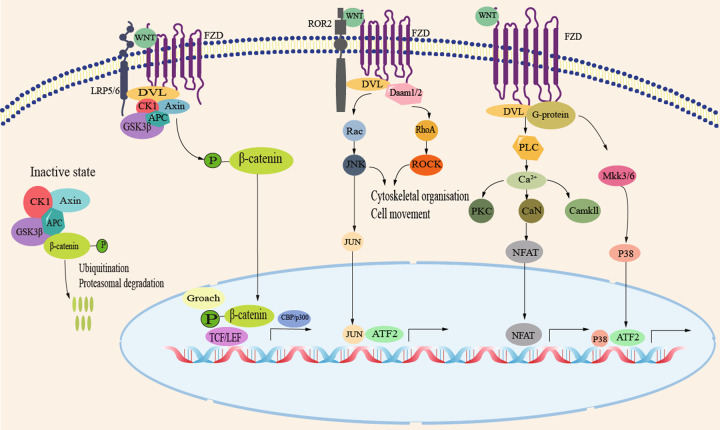Fig. 2. WNT4 signaling pathway.
WNT4 regulates at least three distinct intracellular signaling pathways: β-catenin, planar cell polarity (PCP)/JNK, and Ca2+/CaMK pathways. In canonical WNT pathway, extracellular WNT ligand binds to FZD and LRP5/6 on the cell membrane and recruits DVL protein to promote dissociation of the β-catenin destruction complex, followed by accumulation of β-catenin, which translocates to the nucleus to interact with target downstream signaling molecules and activate intracellular signaling cascades. In WNT/PCP/JNK pathway, WNT4 binds to FZD and interacts between DVL and Dvl-associated activator of morphogenesis (DAAM) to activate the small GTPases Rac1 and Ras homolog gene family member A (RHOA). Rac1 activates JNK and phosphorylates c-Jun. In WNT/Ca2+ pathway, WNT4 ligand binds to FZD2 receptor and G protein subunits at the cell membrane and recruits DVL protein to promote PLC, leading to open calcium channels for Ca2+ release, resulting in intracellular Ca2+ accumulation. Ca2+ can activate the phosphates calcineurin (CaN) and several calcium-dependent kinases, including PKC and calmodulin-mediated kinase II (CaMKII). The phosphates calcineurin, in turn, activates the nuclear factor of activated T cells (NFAT) to regulate downstream cascades. The G protein-induced activation of p38 via mitogen-activated protein kinase 3/6 (MAPK 3/6) results in phosphorylation of activating transcription factor 2 (ATF2) on Thr69 and Thr71 to nuclear transcription.

